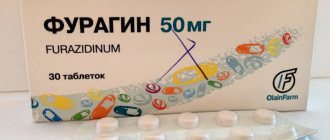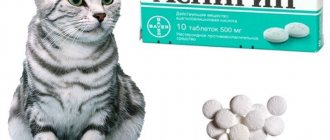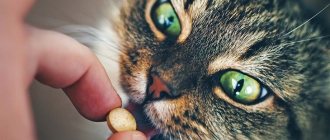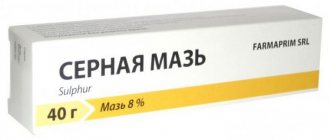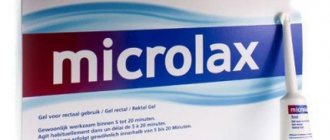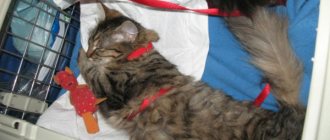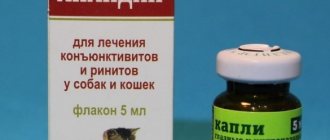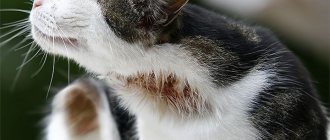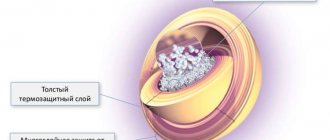Dosage of injection quamatel for cats (1 bottle of 20 mg diluted in 5 ml of solvent):
- 1 kg - 0.25 ml
- 2 kg - 0.5 ml
- 3 kg - 0.75 ml
- 4 kg - 1 ml
- 5 kg - 1.25 ml
- 10 kg - 2.5 ml
Gastric ulcers and erosions are relatively common complications of renal failure, gastric bloating, steroid treatment, nonsteroidal anti-inflammatory drug (NSAID) administration, and primary gastric disease. Drug therapy is often necessary to treat ulcers and prevent further health problems in cats.
Kvamatel is an antiulcer drug of the histamine receptor-2 (H-2) blocker class. Stimulation of H-2 receptors (targets) located on the cell membranes of stomach cells leads to the secretion of gastric juice and hydrochloric acid, in particular. By blocking these receptors, cats' stomach acid will not be released, allowing the ulcer to heal.
Kvamatel and other H-2 blockers are useful in the treatment and prevention of gastric ulcers
(duodenum) and intestines, as they prevent the activation of this cellular receptor. Other drugs with similar effects include ranitidine (Zantac®), nizatidine (Axid®), and cimetidine (Tagamet®). This drug is not approved for use in animals by the US Food and Drug Administration, but veterinarians legally prescribe it as an off-label drug.
- Quamatel is available over the counter but should not be administered to cats except under the supervision and direction of a veterinarian.
- Brand names and other names of quamatela
- This drug is registered for use in humans only.
- Human formulations: Quamatel, famotidine, Pepcid® (Merck) and various generic drugs
- Veterinary drugs: no
Indications
Animals can take this drug if they have diagnosed colitis.
Veterinarians prescribe Kvamatel to cats for various problems with food processing in the gastrointestinal tract. In addition, the medicine is prescribed to cats for bleeding in the stomach, inflammation of the gastric walls, ulcerative lesions of the gastrointestinal tract, colitis and other pathologies caused by increased acidity of digestive juice. Veterinarians recommend Kvamatel to cats both as a one-time dose to relieve an attack, and as part of a complex course of therapy. Taking medication may be necessary before surgery to prevent gastric contents from being released into the airways.
Using quamatel for cats
Kvamatel is used in the treatment and prevention of gastric (stomach) and intestinal ulcers in cats. Kvamatel promotes the healing of ulcers in animals with ulcers or erosions (shallow depressions in the gastric mucosa). Kvamatel may be useful in treating stomach inflammation caused by kidney failure. Another use is to treat gastric reflux disease, a condition similar to “heartburn” in humans and caused by stomach acid moving up into the lower esophagus. To reduce damage to the esophagus, this drug is prescribed to cats.
Cats with mast cell tumors can be treated with Quamatel or similar drugs, as these tumors can produce large amounts of histamine.
general description
Kvamatel in pharmacies comes in the form of tablets and powder, which is used to prepare a solution for injection. The tablets are round in appearance and pink in color. The concentration of famotidine, the active substance, can be 10, 20 or 40 mg. The composition also includes auxiliary components:
- titanium dioxide;
- magnesium stearate;
- microcrystalline cellulose;
- red iron oxide;
- corn starch, etc.
Tablets are packaged in blisters of 14 pieces. There may be one or two such blisters in a cardboard package.
The white powder used to prepare the solution is packaged in glass bottles sealed with rubber stoppers. Bottles with powder are equipped with a solvent. Sodium chloride solution is used as a solvent. It is packaged in sealed glass ampoules. One cardboard package contains 5 bottles and the same number of ampoules with solvent.
Precautions and side effects
Although Quamatel is generally safe and effective when prescribed by a veterinarian, it may cause side effects in some cats. Kvamatel should not be used in animals with hypersensitivity or allergy to the drug. Kvamatel should be used with caution in cats with kidney or liver disease (dose reduction required). Kvamatel may interact with other medicines. Check with your veterinarian to determine if other medications your pet is receiving may interact with Quamatel. Such drugs include digoxin and ketoconazole.
Instructions for use
Kvamatel should be given to cats strictly according to indications in accordance with the prescriptions of the veterinarian. To calculate the dosage, you need to weigh the purr and measure 1 mg of medication for each kilogram of the pet’s weight. They give Kvamatel in the morning and evening along with food. Injections are also administered twice a day in a dosage depending on body weight. Veterinarians recommend feeding the animal medicine during the period when there is no vomiting. Motilium, which is also intended for human therapy, is considered an effective antiemetic. It is available in tablets and suspensions. The dosage of Motilium is 0.05-0.1 g per 1 kg of purring weight half an hour before meals.
Learn about essential drugs in animals
- Vaccination of puppies
- Vaccination of cats against rabies
- Vaccination of small animals
- Vaccination for a kitten
- Why vaccinate dogs against rabies?
- Vaccinations for kittens
- Nobivac triquet trio
- Nobivak dhppi
- Puppy vaccinations
- Vaccinations for cats
- Tick vaccination for dogs
- What vaccinations for dogs?
- Ursofalk for cats
- Serenia for animals
- Ursofalk suspension for dogs, dosage
- Marfloxin for veterinary medicine
- How to use serenia in dogs
- Graying in cats
- Heptor for dogs
- Lidocaine for dogs
- Heptor for cats
- Lidocaine for cats
- Heptral for a dog
- Can cats use marfloxin?
- Marfloxin for cats - instructions
- Heptral in cats
- Dirofen suspension for cats: instructions
- Vetom 1 for cats
- multifel for cats
- Use of fosprenil in cats
^Top
"Mini" and other analogues
It happens that for some reason this medicine is not suitable for your pet. There are analogues that you can try.
The closest of them:
- Kvamatel-mini. Differs in a lower dosage of the active substance. Suitable for particularly small breeds or puppies. Perfectly eliminates heartburn and belching. It has contraindications during pregnancy and breastfeeding.
- Famotidine. A Russian-made drug that has minor differences from Kvamatel.
In addition, the doctor may prescribe the following products with the same active ingredient:
- gastrotide;
- ulfamide;
- Famatel;
- famodingexal;
- famozol;
- famosan, etc.
Why is Kvamatel prescribed?
Quatamel is mainly used to treat defects associated with increased secretion of all gastric juice - i.e. for problems of the digestive tract. In ampoules and tablets, the product has the following indications for use:
In particular, the indications of Kvamatel are aimed not only at the direct treatment of the indicated gastric pathologies, but also at their prevention. In most cases, its use helps to avoid the development of a sharp postprandial hyperacid state. The latter case is usually corrected through surgery. It is also used for the general neutralization of pancreatitis.
Also, Quatemal should not be taken by those who have any intolerance to its structural components. This is very important because... in this case, the indications indicate serious side effects.
It is produced in the form of tablets for internal administration, and in the form of a solution in ampoules for intravenous administration. Intravenous injections must be accompanied by an appropriate prescription from a specialist.
Gastritis in cats: causes and symptoms, treatment and prevention, what to feed
Gastritis in cats is an inflammation of the stomach lining. Our smaller brothers, like people, are susceptible to this disease. But, unlike us, cats cannot complain of stomach pain, so it is very important to recognize gastritis in a pet in the initial stages in order to prevent complications of the disease.
Gastritis can be acute or chronic. Most often, adult cats get sick, but due to improper feeding, the disease can also develop in kittens.
Read about the ranking of the best wet and dry food in 2015.
Causes of gastritis in cats
Acute gastritis in cats develops suddenly. Hot food such as porridge, fish or, on the contrary, too cold can cause harm to the delicate mucous membrane of the stomach. And if the cat also eats food that is too hot or cold very quickly, this only increases the traumatic effect on the stomach.
Negative factors that can provoke gastritis in a cat also include:
- stress;
- the animal has chronic liver and kidney diseases;
- food from the human table that contains spices, garlic, onions and herbs is unacceptable for the cat’s body;
- fatty, stale food;
- overfeeding;
- bacteria of the genus Helicobacter;
- allergy;
- worms;
- accumulation of hairballs in the stomach;
- taking certain medications.
Learn more about the nutrition of the Scottish Fold.
Forms of gastritis in cats
Acute gastritis, as I mentioned above, develops suddenly. The gastric mucosa becomes swollen and reddened.
Increased secretion of mucus begins, which prevents food from interacting with gastric juice.
As a result, it is not the breakdown of food that occurs, but its fermentation and rotting and, as a result, decay products and gases that poison the animal’s body are formed.
With chronic gastritis, constant specific changes occur in the cat’s body, namely: the formation of gastric juice is disrupted, either its insufficiency occurs or, on the contrary, hypersecretion; the walls of the mucous membrane are damaged, and the vessels in the stomach become fragile, which carries the risk of bleeding.
Uremic gastritis in cats is a consequence of kidney disease. When the kidneys fail to cope with their work, the body itself begins to be poisoned by the products of protein metabolism. Urea accumulates in the gastric juice, which leads to uremic gastritis.
Eosinophilic gastritis rarely develops in cats and is caused by allergies, the presence of artificial dyes in food, medications, etc. With this type of gastritis, the stomach becomes inflamed due to the accumulation of eosinophils in the mucous membrane. Eosinophils are blood cells that sharply increase in the body during allergic conditions and helminthic infestations.
When a cat has gastritis, the acidity of the gastric juice may change; as a result, gastritis can be with high, low or normal acidity. This is a very important factor when prescribing treatment.
Symptoms of gastritis in cats
Signs of acute gastritis:
- decreased or sudden lack of appetite;
- nausea, vomiting mixed with bile;
- regurgitation of food;
- in feces there are remains of undigested food;
- loose stools or, conversely, constipation;
- the animal has apathy, the cat lies a lot, refuses to play;
- due to pain, the abdominal muscles are tense, and the cat does not allow itself to be picked up, much less touched;
- mucous membranes become pale and acquire a yellowish tint;
- a white coating forms on the tongue;
- the coat is dull;
- There is an unpleasant odor coming from the cat's mouth.
How does chronic gastritis manifest in cats?
The inflammatory process in chronic gastritis either resumes or subsides, and the symptoms are the same as in the acute form of gastritis.
In the chronic course of the disease, the cat develops acute attacks of the disease, which last from several hours to a couple of days.
After this, the cat’s condition returns to normal, but this does not at all indicate the animal’s recovery; it simply goes through the stage of exacerbation of chronic gastritis.
Diagnosis of gastritis in cats
Since gastritis can be a consequence of other diseases, the diagnosis must be thorough in order to find out the cause of the disease and prescribe adequate and effective treatment. This is especially true for cats that regularly suffer from gastrointestinal disorders.
To diagnose gastritis in cats use:
- examination of the animal;
- taking anamnesis;
- Analysis of urine;
- blood analysis;
- Ultrasound of the gastrointestinal tract;
- determination of gastric juice acidity.
In severe cases of the disease, the following is used to diagnose gastritis:
- X-ray with contrast agents;
- endoscopic examination;
- biopsy.
